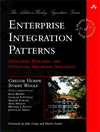This is my true passion. I love making data flow between systems and was introduced to EAI toolsets about 6 and 1/2 years ago with SeeBeyond and the
At the time, I was managing a whole constellation of crappy VB6 apps that were inconsistently written, had different alerting mechanisms (some wrote to the event log, some sent email, some wrote log files, some called out to Blat for god sake).
I knew there had to be a better way and really got sucked up into finding one.
Along the way I discovered that the problems that I was looking at were not unique - of course not - every good programmer know the GOF patterns, but what I also found was the excellent work by Gregor Hohpe and Bobby Woolf. I swear by this book. I take it to every meeting with executives and managers.
The patterns are great and I must say that the layout and structure of the book is very unique. It is the most accessible and friendly patterns book I've ever seen.
 Enterprise Integration Patterns Enterprise Integration PatternsGregor Hohpe and Bobby Woolf ISBN 0321200683 650 pages Addison-Wesley |
